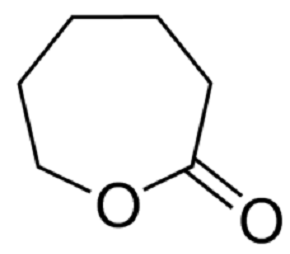ε-Caprolactone: Applications in Nanotechnology and its Toxicity
Description
ε-Caprolactone is a lactone (a cyclic ester) possessing a seven-membered ring. This colorless liquid is miscible with most organic solvents and water.

Applications in Nanotechnology
Caprolactone is a monomer used in the production of highly specialised polymers. Ring-opening polymerization, for example, gives polycaprolactone.Poly-ε-caprolactone (PCL) is a biodegradable, biocompatible and semicrystalline polymer having a very low glass transition temperature. Due to its slow degradation, PCL is ideally suitable for long-term delivery extending over a period of more than one year. This has led to its application in the preparation of different delivery systems in the form of microspheres, nanospheres and implants. Various categories of drugs have been encapsulated in PCL for targeted drug delivery and for controlled drug release. Microspheres of PCL either alone or of PCL copolymers have been prepared to obtain the drug release characteristics.1
Toxicity
ε-Caprolactone exhibits low acute toxicity by all potentially relevant routes of exposure. The acute oral LD50 for rats was 4290 mg/kg, while the acute dermal LD50 in rabbits was 6400 mg/kg body weight. The primary symptoms following a single high exposure are skin erythema (dermal) as well as apathy and effects on motor coordination and respiration (oral). ε-Caprolactone is considered not-irritating to skin and irritating to eyes.
No studies are available with regard to reproduction and developmental toxicity of ε-caprolactone. However, a well conducted 90-day inhalation repeated dose study showed no macroscopic and histopathological changes on reproductive organs and also other systemic effects were not found during this study. The lack of systemic effects can be explained by the rapid hydrolysis in stomach and blood, resulting in the formation of 6-hydroxyhexanoic acid. Analogues of 6-hydroxyhexanoic acid show no evidence of reproductive or developmental toxicity. For this reason there is no indication for a reprotoxic concern. This is supported by the toxicological profile of structurally similar lactones, where also no organ specific toxicity was observed in long term studies (with up to 2-year exposure).
References:
[1] V.R. SINHA. Poly-?-caprolactone microspheres and nanospheres: an overview[J]. International Journal of Pharmaceutics, 2004, 278 1: 1-208. DOI:10.1016/j.ijpharm.2004.01.044.You may like
Related articles And Qustion
Lastest Price from ε-Caprolactone manufacturers

US $0.00/kg2025-08-22
- CAS:
- 502-44-3
- Min. Order:
- 1600kg
- Purity:
- 99%
- Supply Ability:
- 35 ton per month

US $10.00/KG2025-04-21
- CAS:
- 502-44-3
- Min. Order:
- 1KG
- Purity:
- 99%
- Supply Ability:
- 10 mt





